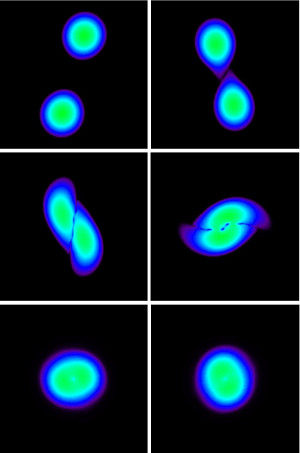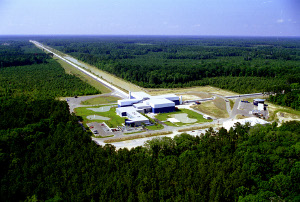|
|  |
From the sound of church bells, anyone can determine - even from miles
away - if the chimes come from a mighty cathedral or a small
chapel. Even without actually seeing the bell, one can distinguish
between a small bell, which produces a high tone, and a large, heavy
bell with a deep rumble. And even when the bells have the same weight,
their shape and material influence the pitch. Scientists from the Max
Planck Institute for Astrophysics have now found a similar
relationship between size and pitch for distant neutron stars. And,
like church bells, the researchers want to use the pitch to determine
the radii and the composition of neutron stars.
Striking a bell excites sound waves in the air; neutron star
oscillations lead to ripples in space-time that propagate with the
speed of light away from the source. These gravitational waves have
been predicted by Einstein in his general theory of relativity, and
scientists hope that they will be able to "hear" the tiny vibrations
of space-time in the coming years with the help of highly sophisticated
experiments (Fig. 2).
But how do you get a neutron star to start vibrating? Above all, the
researchers need patience. Many neutron stars occur in binary systems
where they orbit each other, slowly getting closer over the
course of several 100 million years. Finally, the two stars with
diameters of a few ten kilometres collide and form a single star that is
much heavier (see Fig. 1). The collision excites strong oscillations in
the newly formed neutron star and leads to the emission of measurable
gravitational waves. According to predictions, there should be a large
number of such binary star systems in neighbouring galaxies to our
Milky Way. Therefore, chances are not bad to witness such a merger in
the future. The latest generation of gravitational wave detectors will
be able to monitor thousands of galaxies at the same time. If a
collision occurs every 10,000 to 100,000 years in each galaxy (as is
expected), the super-sensitive detectors will not miss it.
With computer simulations, the scientists at MPA studied how the pitch
of the emitted gravitational waves depends on the size of the neutron
stars. The star diameter depends on the internal structure and
properties of the neutron-star matter. Since the latter are not well
known, the researchers used many different suggestions for
neutron-star matter in their calculations and determined the
corresponding "sound" of the collision. The pitch varies between the
tones b´´´ and b´´´´. As expected, smaller stars produce higher tones,
while more extended objects produce a lower tone (see Fig. 3). The
simulations of the scientists thus open up the fantastic possibility
to accurately measure the size (to within a few 100 metres) of an
object that is many million light-years away from Earth.
The new results are particularly exciting, because neutron stars are
very extreme objects. With diameters of 20 to 30 kilometers, their
mass of 1.5 to 2 times the solar mass is compressed to densities
exceeding those in atomic nuclei. Such conditions cannot be created
and studied in any laboratory on Earth. Nevertheless, matter at such
high densities is of particular interest for many researchers. In such
an extreme environment, fundamental processes of nuclear and particle
physics emerge, such as interactions between elementary particles, and
determine the properties of neutron-star matter. The observation of
signals from distant astronomical objects therefore allows a deeper
insight into the most fundamental building blocks of nature.
Andreas Bauswein, Hannelore Hämmerle, H.-Thomas Janka
Contact:
Dr. Andreas Bauswein
Max Planck Institute for Astrophysics, Garching
Tel.: +49 89 30000-2236
email: abauswein mpa-garching.mpg.de mpa-garching.mpg.de
Dr. Hans-Thomas Janka
Max Planck Institute for Astrophysics, Garching
Tel.: +49 89 30000-2228
email: hjanka mpa-garching.mpg.de mpa-garching.mpg.de
Dr. Hannelore Hämmerle
Press Officer
Max Planck Institute for Astrophysics, Garching
Tel. +49 89 30000-3980
E-mail: hhaemmerle mpa-garching.mpg.de mpa-garching.mpg.de
Original publication
Andreas Bauswein, Hans-Thomas Janka,
"Measuring Neutron-Star Properties via Gravitational Waves from Neutron-Star Mergers",
Physical Review Letters 108, 011101 (2012),
 http://prl.aps.org/abstract/PRL/v108/i1/e011101 http://prl.aps.org/abstract/PRL/v108/i1/e011101
Nikolaos Stergioulas, Andreas Bauswein, Kimon Zagkouris, Hans-Thomas Janka,
"Gravitational waves and non-axisymmetric oscillation modes in mergers of compact object binaries",
Monthly Notices of the Royal Astronomical Society 418, 427 (2011),
 http://onlinelibrary.wiley.com/doi/10.1111/j.1365-2966.2011.19493.x/full http://onlinelibrary.wiley.com/doi/10.1111/j.1365-2966.2011.19493.x/full
|



 mpa-garching.mpg.de
mpa-garching.mpg.de